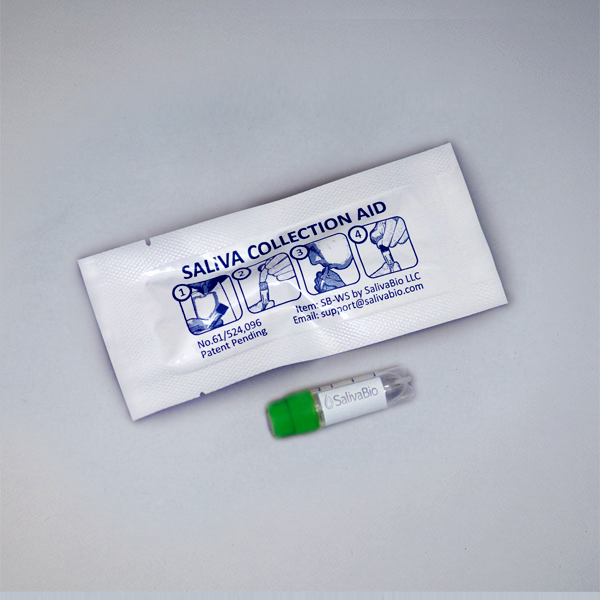Need Help?
Ask an expert
1. How to collect Salivary Interferon Gamma
APPROVED SALIVARY CYTOKINE COLLECTION METHODS
Salivary Cytokine Collection Protocol
Collection volume, general considerations, and basic guidelines to maximize salivary Cytokine sample integrity. Use this analyte-specific collection protocol to plan you collection methodology and sampling schemes.

2. How to Assay for Salivary IFN-gamma
Send Saliva Samples to Salimetrics
Add to StudyEasy and accurate results from the most trusted Salivary Bioscience Laboratory.
Order Code5209
3. Technical Summary
| Analyte Summary | |
|---|---|
| Analyte: | Interferon Gamma |
| Aliases: | IFN-γ, IFN-gamma |
| Serum-Saliva Correlation: | NA |
| Optimum Collection Volume: | 100 μL |
| Assay Summary | |
|---|---|
| Methodology: | ECL |
| Sensitivity: | 0.37 pg/mL |
| Assay Range: | 0.37 – 4760 pg/mL |
| Assay Type: | Quantitative |
Background
*Available as part of the Salimetrics Cytokine Panel - Not available as an individual test*
Human interferon gamma (IFN-γ, IFN-gamma) is mainly produced by lymphocytes as a glycosylated 19.3 kilo Dalton (kDa) cytokine that exists as a non-covalently linked homodimer. In general, IFN-gamma is a central regulator of innate and adaptive immune responses mounted against viral infection, mediates cell mediated immunity such as anti-tumor immune responses and is a hallmark of T helper type 1 (Th1) immune responses (1,2). In this capacity, IFN-gamma is a potent activator of macrophages and induces Class I and Class II MHC (major histocompatibility complex) expression. When IFN-gamma is expressed by Th1 lymphocytes, it polarizes the T cell response towards Th1 in a positive feedback loop by inducing Th1 differentiation from Th0 cells, while suppressing Th2 differentiation. Measurements of IFN-gamma can be used to identify T-cell driven pathology. Dysregulation of IFN-gamma is associated with a number of disorders including autoimmune diseases, Huntington’s disease and IFN-gamma levels are increased during hepatitis C infection and Tuberculosis (3). IFN-gamma may also be used as a general indicator of active viral infection. Since IFN-gamma is elevated during stress induced reactivation of herpes virus family members, such as Herpes Simplex Virus 1 (HSV1) or Epstein Barr Virus (EBV), it is possible that levels of salivary IFN-gamma may be used as a marker for stress related immune suppression. This use of IFN-gamma as a surrogate for stress induced immune suppression is an area of research that may add to others, such as cortisol, in the stress field of study.References & Salivary IFN-gamma Research
- Kak G, Raza M, Tiwari BK. Interferon-gamma (IFN-gamma): Exploring its implications in infectious diseases. Biomol Concepts. 2018;9(1):64-79.
- Ivashkiv LB. IFNgamma: signalling, epigenetics and roles in immunity, metabolism, disease and cancer immunotherapy. Nat Rev Immunol. 2018;18(9):545-58.
- MacLean E, Broger T, Yerlikaya S, Fernandez-Carballo BL, Pai M, Denkinger CM. A systematic review of biomarkers to detect active tuberculosis. Nat Microbiol. 2019;4(5):748-58.
- Rajendran P, Chen YF, Chen YF, Chung LC, Tamilselvi S, Shen CY, et al. The multifaceted link between inflammation and human diseases. Journal of cellular physiology. 2018;233(9):6458-71.
- Val M, Sidoti Pinto GA, Manini L, Gandolfo S, Pentenero M. Variations of salivary concentration of cytokines and chemokines in presence of oral squamous cell carcinoma. A case-crossover longitudinal prospective study. Cytokine. 2019;120:62-5.
- Wang X, Kaczor-Urbanowicz KE, Wong DT. Salivary biomarkers in cancer detection. Med Oncol. 2017;34(1):7.
- Huck O, Buduneli N, Bravo D. Inflammatory Mediators in Periodontal Pathogenesis. Mediators Inflamm. 2019;2019:2610184.
- Silva N, Abusleme L, Bravo D, Dutzan N, Garcia-Sesnich J, Vernal R, et al. Host response mechanisms in periodontal diseases. J Appl Oral Sci. 2015;23(3):329-55.
- Gaba FI, Sheth CC, Veses V. Salivary biomarkers and their efficacies as diagnostic tools for Oral Squamous Cell Carcinoma: Systematic review and meta-analysis. J Oral Pathol Med. 2018.
- Slavish DC, Graham-Engeland JE, Smyth JM, Engeland CG. Salivary markers of inflammation in response to acute stress. Brain, behavior, and immunity. 2015;44:253-69.</li
- Sheth CC, Lopez-Pedrajas RM, Jovani-Sancho MDM, et al. Modulation of salivary cytokines in response to alcohol, tobacco and caffeine consumption: a pilot study. Sci Rep. 2018;8(1):16687.
 Contact: Salimetrics (USA)
Contact: Salimetrics (USA)



